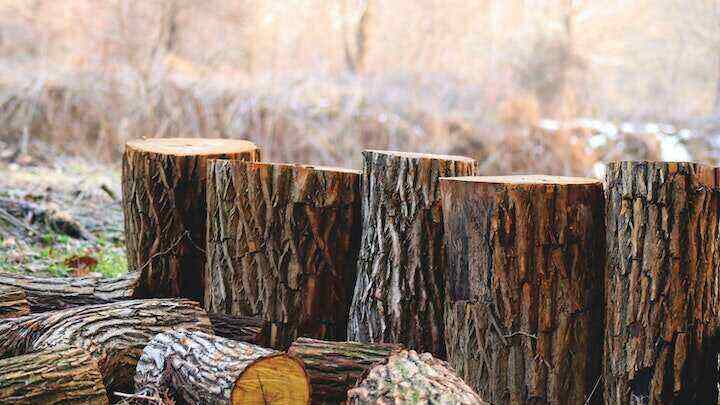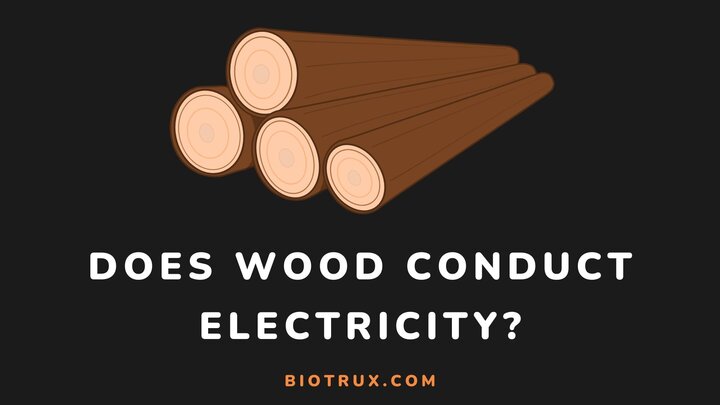Wood is a dielectric material and under normal circumstances, should not conduct electricity. However, there are a few occasions where it can conduct electric current.
When this happens, the wood is either wet or extremely dry and exposed to high voltage (as seen in power lines). The presence of salt (maybe mixed with water or not) can also make wood a conductor.
Hence, the concept of whether wood conducts electricity or not can be a little confusing if you do not have a full idea of what may be responsible for each scenario.
This guide will explain why woods are generally insulators, their electrical conductivity, and their resistivity.
It will also feature scenarios that can make wood conductors and the major types of wood with this ability.
Is Wood a Conductor of Electricity?

Once again, wood is an insulator or a dielectric material. This is because conduction only takes place when electrons in a material are free-flowing or can move from one material to another.
For wood, this is not the case. Its electrons exhibit a very tight bond and are stable, hence, are not allowed to flow from one end to another.
Wood will only conduct electricity when it comes in contact with external factors such as water, dirt, and salt. In this case, wood is not the one doing the conducting, it is the water and other contaminants associated with it.
Extremely dry woods may also conduct current when they come in contact with a high voltage such as electrical lines. This is why wooden ladders are usually a rare sight around power lines.
What are the Electrical Conductivity and Resistivity of Wood?
Now that it is safe to assume woods are mostly insulators but can be conductors in a few instances, let’s find out how well they conduct and resist electricity (resistivity):
Electrical conductivity of wood
For context, the electrical conductivity of any material is the measure of its ability to let electric current flow through it. In other words, it rates the conducting ability of a material.
Conductors generally have a high electrical conductivity denoted by σ and a given unit of siemens per meter (S/m). The formula for the electrical conductivity of a material is:
σ = l/RA
Where:
- R = Resistance of the material
- A = Cross-sectional area of material
- L = Length of material
The electrical conductivity of dry wood, which is an insulator, usually lies between 10−16 to 10-14 S/m. For damp wood, the value increases to around 10−4 to 10-3 S/m.
Hence, damp wood stands a better chance of conducting current than dry wood.
Electrical resistivity of wood
The resistance or resistivity of a material is the major force against conductors within a material. Wood has higher resistivity, which is a clear sign that it is an insulator.
Resistivity is denoted by ρ, and it is measured in Ohm-meter (Ω m). The formula for the electrical resistivity of any material is given as:
ρ = RA/l
Where:
- R = Resistance of the material
- A = Cross-sectional area of material
- L = Length of material
The value of electrical resistivity for dry wood is usually between 1×1014 to 1016. For damp wood, it is lower and usually between 103 and 104 Ω m.
Factors That Affect The Electrical Conductivity of Wood
There are a few factors that affect the electrical conductivity of wood. Whatever these factors do to the electrical conductivity of wood, it will do the opposite to resistivity.
1. Temperature
Temperature is directly proportional to the electrical conductivity of wood. In other words, an increase in temperature means better conductivity and vice versa.
At a very high temperature, the ions and viscosity level (resistance) of wood become active and weakened respectively. The process of measuring the conductive ability of wood based on temperature is known as the temperature coefficient.
The value will either be positive or negative and it is usually stated in “relative change per degree Celsius” or % per °C.
2. Moisture
Wood moisture is mostly related to water and other liquids with a great affinity for contaminants or impurities. Moisture is also directly proportional to the electrical conductivity of wood.
This means more moisture is equivalent to increase in conduction and vice versa. This is why it is not safe to use wet trees as a cover when it is raining.
Heavy rains usually attract lightning and thunder which may lead to aid conduction in wood. When evaluating the degree of moisture in woods, “high-frequency moisture meters” are very ideal.
This device evaluates moisture in percentages (%) by comparing the level of moisture with the dielectric (insulating) ability of wood. Values below 8% imply a slow electrical conductivity in such wood.
3. Current frequency
When wood comes in contact with high voltage, there is a chance it will conduct electricity irrespective of its state (dry or not). Hence, it is safe to say the frequency of current reaching out to wood is also directly proportional to its electrical conductivity.
4. Special finishes or species
This is very common in home and office furniture. When materials that are good conductors of electricity are used as finishing, there is a chance such furniture will conduct electricity.
Also, woods either have horizontal or vertical fibers. Horizontal fibers are better conductors than vertical fibers. This is because current flow better along the grain than across.
5. Length
Length is inversely proportional to the electrical conductivity of wood. Hence, long wood conducts electric current more slowly than short ones. This is because electricity flows faster in short pieces than in longer ones.
6. Thickness
Thickness is directly proportional to the electrical conductivity of wood. This means thicker wood will conduct electricity more effectively than short ones.
Common Woods That Conduct Electricity When Wet
Not all wet woods conduct electricity. This is why species and frequency of voltage matter. Here is a list of common hardwood and softwood that conducts electric current:
- Hardwood – Red oak, Black Cherry, White ash Raft, and Red maple
- Softwood – Spruce Cedar, Hemlock, Fir tree, and Pine tree
Does Wood Conduct Heat?
Heat can be transferred via conduction, convection, and radiation. Unfortunately, none of these processes makes wood an effective material for heat transmission.
This is so because its electrons are not mobile, hence, there can not be a transfer of heat from one wood to another.
FAQs
Is wood a better conductor than metal?
Wood is not a better conductor than metal.
In fact, metals are considered the most conductive materials on earth.
Can a wooden pencil conduct electricity?
A wooden pencil should not conduct electricity under normal circumstances.
However, if it is wet, exposed to impurities, or high voltage, it may become conductive.
Can wooden poles conduct electricity?
Like wooden pencils, a wooden pole should also not conduct electricity.
However, wooden electric poles may become charged if they are wet or exposed to high voltage.
Wrapping Up
Woods are generally insulators because of their non-mobile and extremely stable (hydrogen-held) electrons. However, they may become conductors in the presence of high temperature, moisture, impurities, high voltage, and due to fiber orientation or finishes.
This is why it is not safe to stand under trees when it is raining heavily (with lightning.) Wood also does not conduct heat – wet or not.
I hope you found this guide helpful. Thanks for reading.

